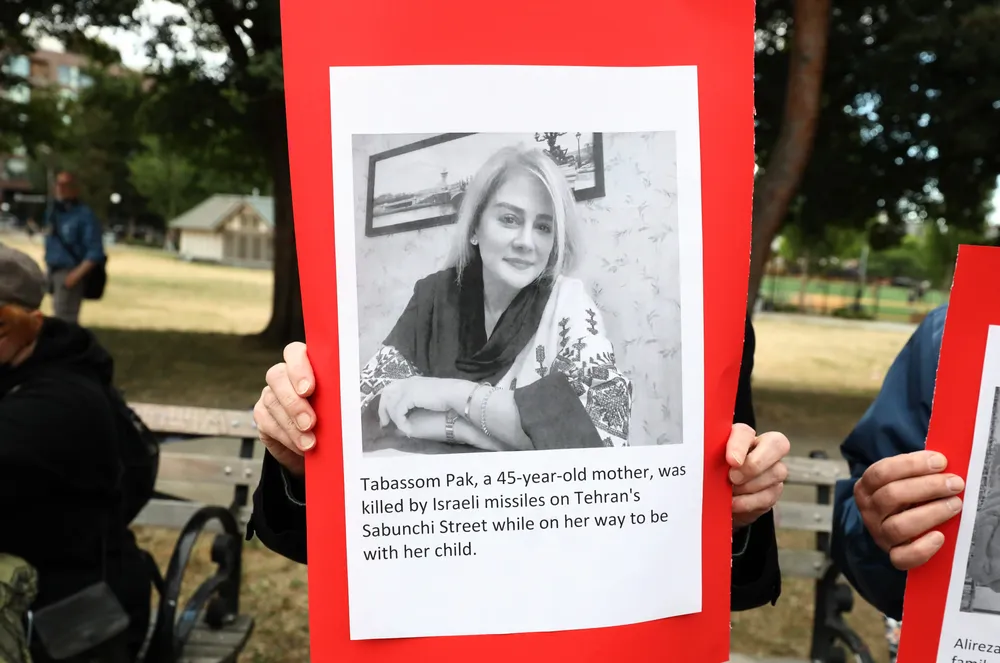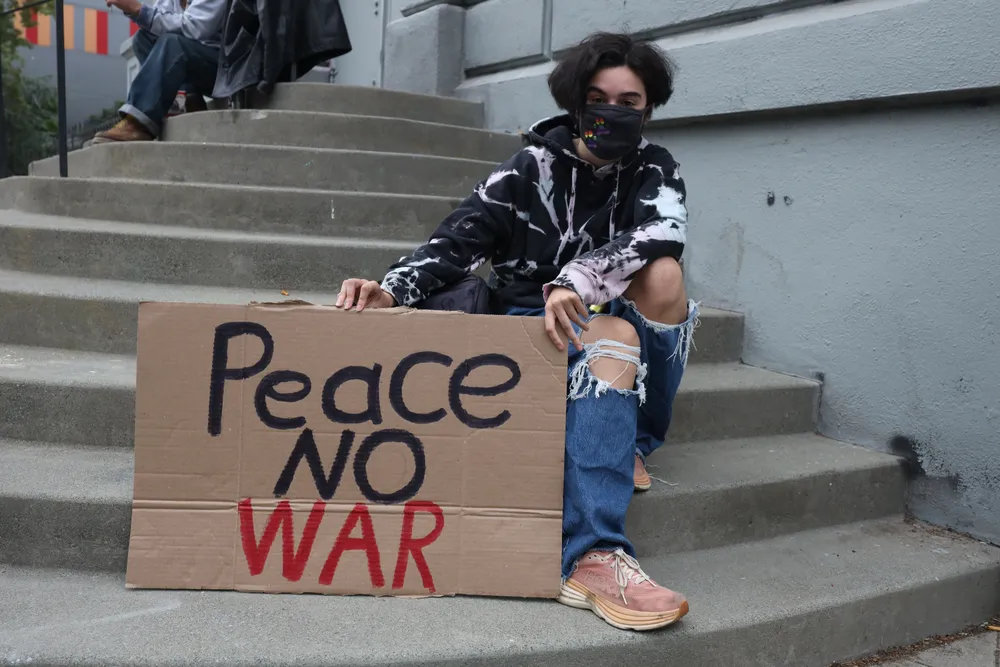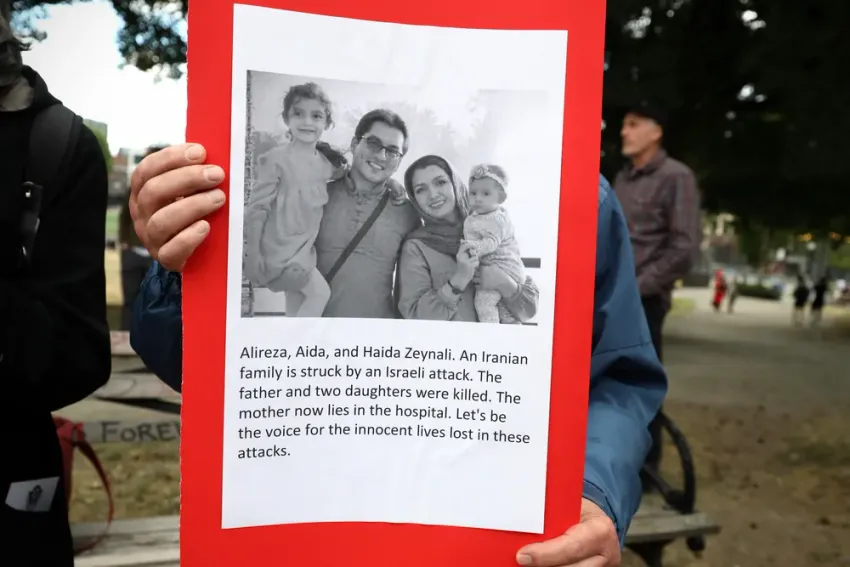Just the day before, Iranian Grassroots Voices organized a No War on Iran protest at Cal Anderson Park on June 18 to rise in support of the people of Iran and stand against overseas aggression; wars and imperialism; dictatorships and fascism; and Zionism and genocide. The intimate gathering brought attention to the potential for Trump to wage war alongside Israel—whose genocide in Gaza has been woven into recent attacks on Iran— fascism, and how US mainstream media presents conflicts to viewers.
About 40 people were present right at the beginning of the protest and some chanted “No more war!” while a person who sat on a nearby bench hit drumsticks against a plastic container with a “solidarity forever” sticker on it. People proudly held Iranian—and a few with American—flags and many more wore keffiyehs, a traditional Palestinian headdress.
“The death toll has now reached hundreds and the smoke of war has risen from all over Tehran and other cities in Iran. Israel, which has been killing the people of Gaza for months and forcing the survivors to die of famine and starvation, has now extended its war-mongering and aggression to the people of Iran with this plan for a new Middle East,” said an Iranian man who spoke into the microphone.
The statement he read was issued by the Iranian Writers’ Association.
“The war between a fascist regime rooted in occupation and genocide—and a government that relies on the bloodshed of its opponents and freedom fighters—not only destroys the lives of the people but also haunts and perhaps sets back years of struggle for freedom and equality,” he said.
The Iranian Writers’ Association’s statement brought up fears that the progress made through the 2022 Iranian freedom movement, which was born from a set of previous uprisings, may disappear because of current Israeli aggression and mass destruction throughout the country.
“Israel, which thanks to its leaders, considers any living thing as a legitimate target right now, with the help of mainstream media in [the] United States pushing back against the public wave against the genocide in Gaza,” he added.
The world watches on as US legacy media slices the voices from both sides, he said, noting how the Islamic Republic relies on the ideas of its founder, which are the killings of opponents.
A quick recap of Iran's history with the US
US relations with Iran are sticky and disturbing: In 1953 US and British intelligence agencies assisted the Iranian military in the overthrow of then Prime Minister of Iran, Mohammed Mossadeq, after he nationalized the Anglo-Persian Oil Company that was owned by the British, according to the Council on Foreign Relations (CFR).
Shah Mohammed Reza Pahlavi was inserted into power and kept his position through the support of the US until being overthrown in the Iranian Revolution (1978-1979). CFR states that the placement of Pahlavi into office by foreign governments displeased many Iranians.
The Islamic Republic of Iran took power after the revolution, with there being only two supreme leaders: Ayatollah Ruhollah Khomeine and Ali Khamenei (who currently reigns), who created an oppressive republic.
For decades, US relations in the Middle East have been fixated on Iran’s natural resources: lucrative oil. Under immense pressure from the US and the United Kingdom, Pahlavi penned the Consortium Agreement of 1954 into action, which gave 40% ownership of Iran’s nationalized oil industry to US, French, and British oil companies—for 25 years.
To regain control, Iran, alongside four other countries, created the Organization of the Petroleum Exporting Counties, resulting in a spike in profits in the 1970s. But, the US government grew concerned after its oil was embargoed in 1973, and has a history of demonizing Iranian people, with former President George W. Bush calling the country a part of the “axis of evil,” in the early 2000s.

Another US and Middle East war?
During the No War on Iran protest, people held signs with pictures of Iranian people–families, mothers, and children—who were murdered by Israeli missiles: Tabassom Pak was a 40-year-old mother on her way to visit her child in Tehran when she was killed.
“The people of Iran are under fire. They are attacked by Israeli aggressions by the US-manufactured missiles, by the silence of the so-called international community, and by betrayals of those who put profits before people,” another speaker said.
This month, Israel launched targeted attacks on Iran’s military and nuclear facilities—a plan that Prime Minister Benjamin Netanyahu had been brewing for weeks. Iran responded by firing a missile which it claims to have unintentionally hit an Israeli hospital, injuring several people. In return, Netanyahu said Israel will fight back with full force.
Karoline Leavitt, White House spokeswoman, read a statement where Trump said, “Based on the fact that there’s a substantial chance of negotiations that may or may not take place within Iran in the near-future I will make my decision whether or not to go [to war] within the next two weeks.”
Although Trump claims he’ll be the no-war president, he’s proven time and time again that he’s not a man of his word. Take the basics: the price of eggs in the US is still very high.
At No War on Iran, the second speaker continued by stating that mainstream media in the US is attempting to sell tales of fiction: that Israel’s invasion is targeted with only military and nuclear bases being impacted.
But during the event, one person in the crowd yelled out, “Who’s got an Israeli flag? I’ll light it [on fire]” which created a widely felt discomfort that smoked through the air.
Decolonize Anarchism posted on social media the day after and reviewed the unsettling events. Part of the post was dedicated to “campists,” or people who are divided into major and opposing political groups, believing in the support of one over another. The post noted how Iranians have dealt with extremism, and that extremists have no place in the collective struggle of the people.
“Campists…have the audacity to show up at a spontaneous anti-war rally organized by Iranians, only to parrot support for the Islamic Republic—a fascist regime that executes, imprisons, tortures, and guns down its own people in the streets? How dare you!” the post stated.
Shame on people who root for Iranian missile attacks while friends and family members are bombed, they said, and that it’s shameful to enjoy footage of these attacks while claiming it as an act of solidarity.
“This is voyeuristic sadism dressed up as a resistance. Shame on you…How dare you disrupt spaces we carve out for care, resistance, and collective safety?” it said. “Shame on those who hijack our narratives, occupy our spaces and beat the drums of war. From Palestine to Iran—every oppressive regime will fall. Long live the popular resistance of the oppressed, under fire and occupation.”

Queerness in Iran and the 2022 Freedom Movement
"Tafkhis” is a form of non-penetrable Gay sex that is less punishable under Sharia law, according to Decolonize Anarchism, and “liwat (لواط),” is the more general term for Gay sex which may include penetration, with the punishment ranging from 100 lashes to execution. "Musahaqah (مساحقه)" is a term for Lesbian sex that is punishable by 100 lashes.
Queerness has historically been criminalized in Iran, but the Human Dignity Trust states that Queer relations were largely tolerated until the Islamic Republic of Iran took power in 1979.
But more recently, LGBTQIA+ people in Iran are often arrested which can lead to the death penalty, and like anywhere else, there’s violence against Queers that includes harassment, assault, the denial of basic human rights, and murder.
Alireza Fazeli Monfared was a 20-year-old Gay man who was captured and murdered by his family members in May of 2021 because of his sexual orientation. Monfared was just a few days away from boarding a flight to exit Iran and seek asylum in a different country after a family member outed him.
The 2022 “Woman Life Freedom” uprising in Iran came after officials harshly ramped up the enforcement of draconian veiling laws for girls and women, sometimes using violence or the death penalty.
That year, Iran’s “morality” police violently arrested 22-year-old Mahsa Amini for not wearing a hijab and she later died in custody; a report from the United Nations (UN) states Amini was taken to the Vozara detention center for a “re-education class,” where she collapsed on the ground and was taken to hospital 30 minutes later.
The UN’s fact-finding group said it “established the existence of evidence of trauma to Ms. Amini’s body, inflicted while in the custody of the mortality police,” and that the physical violence she experienced at the hands of these officers led to her death.
Outraged, waves of women in Iran took to the streets after Amini’s funeral where they ripped off their hijabs, with some even setting them on fire while demanding a government change.
During one of the “Women Life Freedom” protests in September of 2022, Nika Shakarami—a 16-year-old Queer activist—was disappeared and found murdered days later. A video recording shows Shakarami standing atop a dumpster in Tehran, lighting fire to a hijab.
The morality police were sent out to confirm she was one of the protest’s leaders, and although she escaped, she was later detained. She was taken to an overcrowded temporary police camp and a detention center but her captors were turned away from both. Shakarami was then murdered by “multiple injuries by caused blows with a hard object,” according to the BBC.
After her murder, a well-known LGBTQIA+ figure in the community dedicated their Lesbian Visibility Award to Shakarami for being a young Queer person who had her life tragically taken from her while fighting for freedom and human rights.
From the US to Iran, Queers have been at the forefront of human rights movements, and know what familial suppression of gender identity and sexuality feels like— and that telling falsities about community members who have died has contributed to the erasure of the vast experiences and history of LGBTQIA+ people.
After Shakarami’s murder, her aunt accused the Queer community of forcing its identities onto her and said that Shakarami was straight.
LGBTQIA+ people always have and will always exist everywhere in the world, with the intersectionality of the women’s movement and Queer rights being intrinsically linked. Iranian Queers have been at the forefront of the country’s protests against the Islamic Republic in recent years.
Looking back on the fight for LGBTQIA+ rights in the US and overseas in Iran this Pride Month—and towards the future—the iconic words of a pioneer of the Queer rights movement stateside and a Black American Trans Woman activist, Marsha P. Johnson, ring loudly: “[There is] no Pride for some of us without liberation for all of us!”
Update
Without congressional approval, on June 21, President Trump bombed three of Iran's nuclear facilities, joining Israel’s war. Trump announced the completion of this "very successful attack" on social media platform Truth Social, where he added that "NOW IS THE TIME FOR PEACE!"
Later that evening, with Vice President JD Vance, Secretary of State Marco Rubio, and Defense Secretary Pete Hegseth standing behind him, Trump delivered an address to the nation. He claimed Iran's the three sites had been "obliterated" and that "Iran, the bully of the Middle East, must now make peace."He said if Iran did not do so, that the US would take out Iranian targets "within minutes."
Trump again took to Truth Social to state, "ANY RETALIATION BY IRAN AGAINST THE UNITED STATES OF AMERICA WILL BE MET WITH FORCE FAR GREATER THAN WHAT WAS WITNESSED TONIGHT."
On June 23, Iran targeted a US air base in Qatar with missiles in response, after a warning to avoid casualties.
Trump announced a ceasefire between Israel and Iran, but after it came into effect, Israel and Iran traded brief and relatively minor attacks. As of June 25, the ceasefire appears to remain in effect.
Meanwhile, Trump's actions have created a distraction: Congress is attempting pass the Big Bad Budget bill before July 4, which will adversely affect millions of Americans if enacted, due to the slashing of social service funding; men in full face masks and uniforms who refuse to identify themselves continue to disappear people into detention facilities; and one Minnesota state legislator, her husband, and their dog were assassinated while another and his wife recover from bullet wounds from the same attacker.
Support the Seattle Gay News: Celebrate 51 Years with Us!
As the third-oldest LGBTQIA+ newspaper in the United States, the Seattle Gay News (SGN) has been a vital independent source of news and entertainment for Seattle and the Pacific Northwest since 1974.
As we celebrate our 51st year, we need your support to continue our mission.
A monthly contribution will ensure that SGN remains a beacon of truth and a virtual gathering place for community dialogue.
Help us keep printing and providing a platform for LGBTQIA+ voices.
How you can donate!
Using this link: givebutter.com/6lZnDB
Text “SGN” to 53-555
Or Scan the QR code below!



